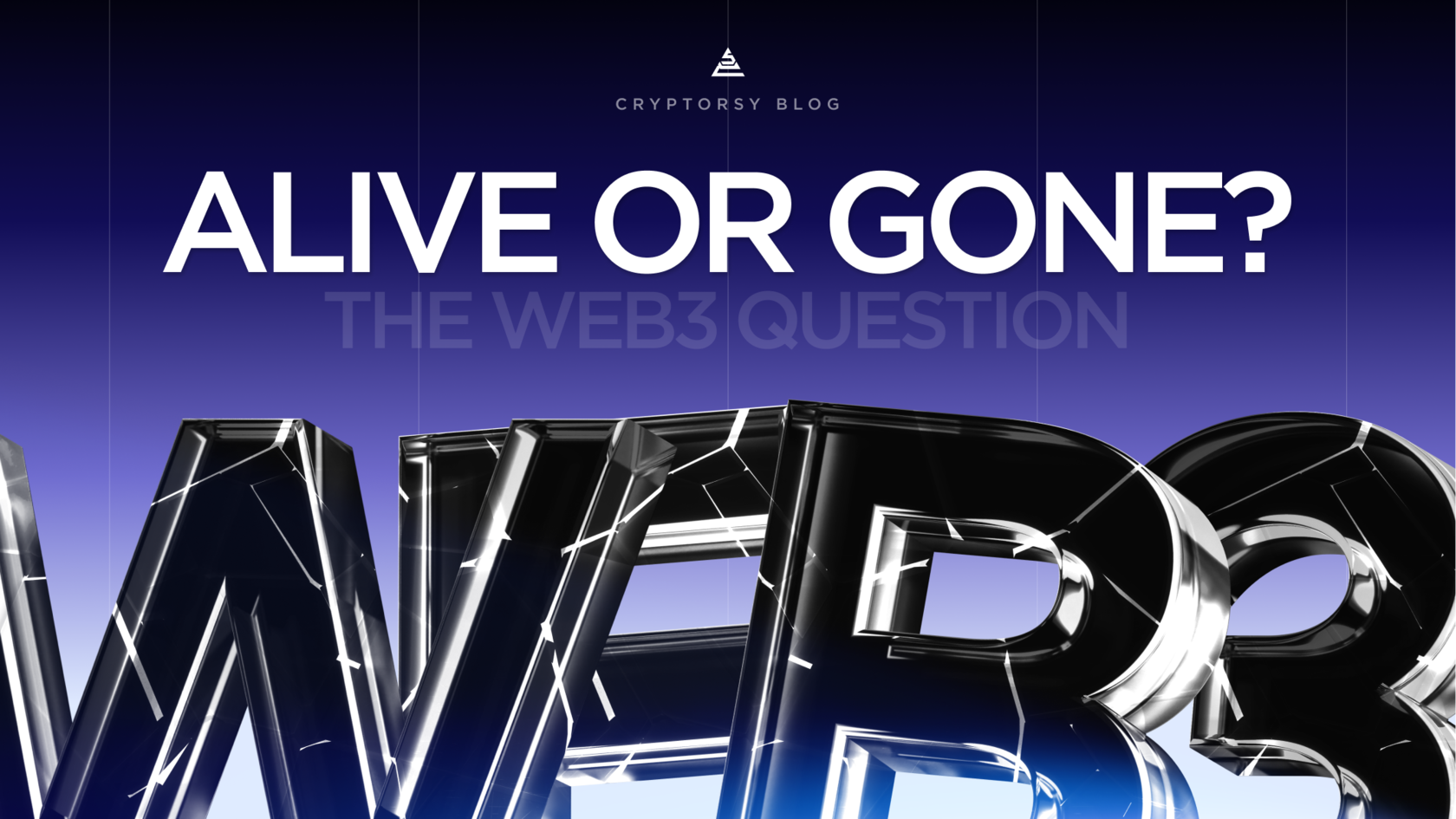
Is Web3.0 dead?
20.11.2023
Gleb Specter
6 min

RELATED
SUBSCRIBE TO OUR BLOG
Bad times in Web3
Is Web3 dead?
Web3 is the next version of the Internet, following the times of static web pages [Web1] and the rise of social media [Web2]. But what exactly is Web3? It's a bit of a mystery. Some folks think of it as a decentralized, blockchain-powered world, while others see it as just a fancier version of Web2 with better privacy and data control.
In this realm, we're empowered to build innovative products, tokenize real assets, and craft extraordinary metaverses. The main goal? Making the customer experience better.
Web3 is always changing and adapting. Even though the term is still figuring itself out, the big ideas of decentralization and giving power to users are at its heart. So, it's not just a fancy word; it's a cool and evolving concept making waves in the tech world!
In this realm, we're empowered to build innovative products, tokenize real assets, and craft extraordinary metaverses. The main goal? Making the customer experience better.
Web3 is always changing and adapting. Even though the term is still figuring itself out, the big ideas of decentralization and giving power to users are at its heart. So, it's not just a fancy word; it's a cool and evolving concept making waves in the tech world!
Share this article:


Gucci
Coca-Cola
Casio
Starbucks
Web3 had a tough time when cryptocurrencies, like Bitcoin and Ethereum, took a dive. Bitcoin lost a whopping 66% of its value from its peak, and Ethereum also saw a significant drop.
These cryptocurrencies are crucial for many Web3 projects, and their decreasing value made it hard for these projects to get users and investments.
The same kind of trouble happened with NFTs. After a big fuss, things went downhill, and people weren't happy.
And it was precisely such problems in the complex that caused people to ask question:
These cryptocurrencies are crucial for many Web3 projects, and their decreasing value made it hard for these projects to get users and investments.
The same kind of trouble happened with NFTs. After a big fuss, things went downhill, and people weren't happy.
And it was precisely such problems in the complex that caused people to ask question:
Our answer - absolutely not! Web3 is far from dead. Let's make it clear right away that there's a lot more to come.
You can't declare something dead when it hasn't even reached its full potential yet.
The actual realization of Web3, as a fully decentralized and transformative iteration of the Internet, is yet to materialize. It's like a ghost; we've heard the stories and seen the signs, but have we experienced it in its full glory? Still waiting.
Moreover, take a quick glance at the market – ETH is above $2000, and BTC is around $37,000. We're entering a new bullish season, signaling a rise in interest for Web3 that's set to grow even more in the next few years.
The market feels positive, and you can see it in Web3 events worldwide. People from all over are coming together to talk about it. It's a clear sign that Web3 is still alive.
You can't declare something dead when it hasn't even reached its full potential yet.
The actual realization of Web3, as a fully decentralized and transformative iteration of the Internet, is yet to materialize. It's like a ghost; we've heard the stories and seen the signs, but have we experienced it in its full glory? Still waiting.
Moreover, take a quick glance at the market – ETH is above $2000, and BTC is around $37,000. We're entering a new bullish season, signaling a rise in interest for Web3 that's set to grow even more in the next few years.
The market feels positive, and you can see it in Web3 events worldwide. People from all over are coming together to talk about it. It's a clear sign that Web3 is still alive.
Real-World Use Cases
Supply chains are getting smarter by using technologies like blockchain to build trust, transparency, and accountability in global trade.
The energy sector is a bit ahead of the game and has a lot of potential for improvement. Web3 is a perfect fit for solving the energy market's need for a decentralized approach and transforming energy grids.
Traditionally, energy markets relied on big power plants and a one-way flow of power and money. But things are changing. Now, energy companies consider distributed renewable energy, behind-the-meter generation, and even consumers selling energy back to the grid. The power plant isn't just a big facility anymore; it's all of people, with rooftop solar systems, batteries, electric vehicles, and smart appliances forming a connected system.
The problem is, that while the hardware has changed a lot, the software running the grid hasn't caught up. Web2 struggles to make devices owned by different people and organizations communicate effectively.
Enter Web3 technologies – they are just right for the job. Instead of keeping data in separate silos, some systems allows a shared digital space where everyone can maintain their own info and share it securely. This system is already in action in Australia, with utilities and aggregators teaming up to manage a shared system, paying small-scale asset owners for the services they provide.
The energy sector is a bit ahead of the game and has a lot of potential for improvement. Web3 is a perfect fit for solving the energy market's need for a decentralized approach and transforming energy grids.
Traditionally, energy markets relied on big power plants and a one-way flow of power and money. But things are changing. Now, energy companies consider distributed renewable energy, behind-the-meter generation, and even consumers selling energy back to the grid. The power plant isn't just a big facility anymore; it's all of people, with rooftop solar systems, batteries, electric vehicles, and smart appliances forming a connected system.
The problem is, that while the hardware has changed a lot, the software running the grid hasn't caught up. Web2 struggles to make devices owned by different people and organizations communicate effectively.
Enter Web3 technologies – they are just right for the job. Instead of keeping data in separate silos, some systems allows a shared digital space where everyone can maintain their own info and share it securely. This system is already in action in Australia, with utilities and aggregators teaming up to manage a shared system, paying small-scale asset owners for the services they provide.
To sum up
Technological revolutions don't happen overnight; they require time to refine and perfect their innovations. Web3 may not have fully unfolded yet, but remember, the World Wide Web didn't emerge all at once either. Just like Rome wasn't built in a day, the decentralized future is a gradual process.
Those who underestimate new technologies, like Web3, AI, and blockchain, risk falling behind, much like those who doubted the potential of the web2 era.
We're confident that you, too, share our enthusiasm, especially considering the current uptrend in the market.
Now is the perfect time to launch your top Web3 projects. So, let’s do it together!
Those who underestimate new technologies, like Web3, AI, and blockchain, risk falling behind, much like those who doubted the potential of the web2 era.
We're confident that you, too, share our enthusiasm, especially considering the current uptrend in the market.
Now is the perfect time to launch your top Web3 projects. So, let’s do it together!
Who believes in Web3?
The fact that major brands are still investing in Web3 suggests significant ongoing interest in the technology. Companies are incorporating Web3 marketing and technologies into their new strategies.
Check out these famous brands using Web3 now.
Check out these famous brands using Web3 now.
On March 27, 2023, announced a multi-year partnership with Yuga Labs, the IP holder of Bored Apes, Crypto Punks, and others, to explore “the intersection between fashion and entertainment in the Metaverse.”
Also, rewarded Gucci Material NFT holders with an exclusive offer to exchange their tokens for a physical, limited-edition Gucci wallet or a bag at no cost.
Also, rewarded Gucci Material NFT holders with an exclusive offer to exchange their tokens for a physical, limited-edition Gucci wallet or a bag at no cost.
Coca-Cola launched a special NFT collection called "Masterpiece" on Coinbase's Base. It combines classic and modern art with the iconic Coca-Cola bottle. There are eight versions, priced from 0.0011 ETH to 0.014 ETH.
Casio started an interactive user community called the VIRTUAL G-SHOCK project. This community connects users with the G-SHOCK line of shock-resistant watches. They distributed 15,000 limited-edition G-SHOCK CREATOR PASS NFTs for free via the Polygon blockchain, allowing holders to participate in events within the VIRTUAL G-SHOCK community. The distribution began on September 23, 2023.
Starbucks did something cool called Starbucks Odyssey. They used fancy blockchain tech with their rewards system and made special digital collectibles (NFTs) that sold for a lot, like $143,000.
Starbucks Odyssey is like a bonus to their rewards program, and they worked with Polygon, using this special blockchain tech. They made these digital collectibles or NFTs, and Starbucks Rewards members and employees got to join in through fun activities called "Journey Stamps."
Just recently, on August 1, 2023, they launched their eighth NFT collection, "Green Apron," as part of the Web3 Starbucks Odyssey program. It's super limited, only 5,000 of them, and it's all inspired by the original Pike Place Apron.
Starbucks Odyssey is like a bonus to their rewards program, and they worked with Polygon, using this special blockchain tech. They made these digital collectibles or NFTs, and Starbucks Rewards members and employees got to join in through fun activities called "Journey Stamps."
Just recently, on August 1, 2023, they launched their eighth NFT collection, "Green Apron," as part of the Web3 Starbucks Odyssey program. It's super limited, only 5,000 of them, and it's all inspired by the original Pike Place Apron.




The sustained interest from these brands is important because it indicates that Web3 isn't fading away or merely a speculative bet; instead, it's a technology with genuine potential to bring lasting impacts to businesses and consumers.

How much does it cost to cooperate with a crypto marketing agency?
The cost of using a crypto digital marketing company will vary depending on the size and scope of your campaign. However, we believe that our prices are very competitive and offer excellent value for money. If you would like a more accurate quote, please contact us and we will be happy to provide you with a customized proposal to fit your budget.
What are the best marketing channels for my crypto offering?
The best advertising and marketing channels are the ones that will allow you to reach your target audience most effectively within your budget. This will vary depending on your type of cryptocurrency project - whether it’s an ICO or a more well-established offering. However, some of the most popular marketing channels for crypto projects include the following:
- SEO & Content Marketing
- PPC Ads
- Social Ads
- PR & Outreach
- Influencer Marketing
- Online Communities
- Press releases
From what and how exactly we can start a collaboration?
Sure thing, we start with a briefing and underlining your goals, to make it our main focus in the work progress, then we’ll give you a couple of gifts (secret), connect your personal marketing manager to your project and launch campaigns. Just beep us on telegram @cryptorsy_io_bot , email us at hello@cryptorsy.io, leave your request here or book a call on our website. We have a principal position: what starts perfectly, will go on perfectly. So be sure, the process of work will be perfect in detail.
How I can be sure that you’ll deliver results?
As a team of data-driven crypto digital marketers, we place a strong emphasis on ROI. We believe that transparency is key — that's the reason we’ll always keep you up to date with our progress, so you can check out the results at any time.
Our combination of experience, expertise, and flexibility makes us some of the best crypto marketing experts in the industry. Here are some of the ways we ensure our clients get the best results:
Our combination of experience, expertise, and flexibility makes us some of the best crypto marketing experts in the industry. Here are some of the ways we ensure our clients get the best results:
- We have a team of experts who are solely focused on marketing cryptocurrency.
- We stay up to date with the latest industry news and trends.
- We develop creative solutions that are designed to help our clients overcome the unique challenges present in the world of cryptocurrency.
- We are always monitoring our campaigns to ensure they are delivering the desired results.
- We always remain agile and adapt our cryptocurrency strategies as needed.
- We offer competitive pricing to fit your budget without sacrificing quality.
What makes Cryptorsy unique and super valuable to me?
All our benefits: gifts, personal marketing manager, free audit, all services on a high-quality level, super easy-to-take prices, perfect scenario and funnels for result getting, and our powerful web3 network, that we can connect to you (all our relations and guys, that can strengthen your performance).
What do I get if I accept your offer, and what do I lose if I refuse?
Shortly, you’ll lose your dedicated crypto marketing partners that could bring you the highest results in the space because they’ve done this a million times, and why don't we do that with you?
What do you get? You get a successful marketing launch and sustainability in your future because 21+ TOP-level experts will manage your marketing activities!
What do you get? You get a successful marketing launch and sustainability in your future because 21+ TOP-level experts will manage your marketing activities!
Want to hack the stunning growth formula for your project? Our team has prepared something extremely special for you, just leave your application to get yours!
SCHEDULE YOR FREE CONSULTATION NOW












